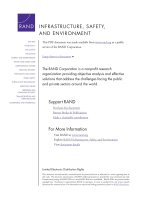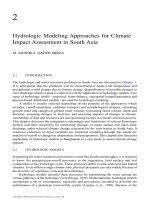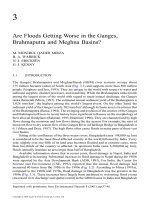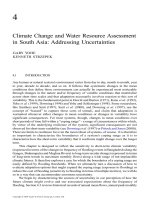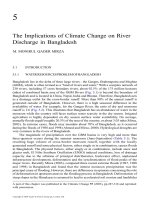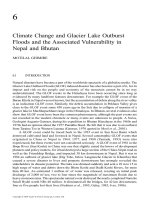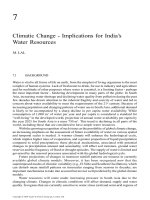Climate variables and waether deliverties
Bạn đang xem bản rút gọn của tài liệu. Xem và tải ngay bản đầy đủ của tài liệu tại đây (468.13 KB, 21 trang )
CLIMATE VARIABLES AND WEATHER DERIVATIVES.
GAS DEMAND, TEMPERATURE AND SEASONALITY EFFECTS
IN THE ITALIAN CASEΨ
Giovanna Zanotti∗ - Daniele Laboratore+ - Giampaolo Gabbi#
1. Introduction
Weather derivatives allow to hedge weather risk that is the financial gain or loss due to
variability in climatic conditions. The market originated in 19982 when the US power
community realised that the high volatility of revenues due to weather variability could be
controlled and, since then, has grown rapidly both in terms of number of contracts concluded
and notional value3 and in terms of variety of industry applications. Economists believe that
something like 70% of the economy is vulnerable to unpredictable weather patterns. Gas utility
and gas distributor companies report severe drops in first quarter earnings when Winter months
are milder than normal4. The quantity of energy required to heat or cool is strongly dependent
on the weather: below normal temperatures in Winter create higher demand for heating; above
normal temperatures in Summer create higher demand for energy to meet air conditioning
needs. Energy companies are then strongly subject to weather variability. Agricultural
companies may suffer serious loss due to below zero temperatures or other abnormal weather
conditions. Ice cream and soft drinks sales revenues are seriously affected by cold or wet
Summers. Ski resorts are influenced by extremely cold temperatures or lack of snow. These are
some of the many cases of companies whose performances are linked to climate. Weather
derivatives can theoretically be designed for almost any weather variable (temperature, rain,
snow, wind..) though most of the contracts have so far been constructed around temperature
forecasts and temperature related underlying5. Weather derivatives contracts are in many aspects
different from “standard” derivatives: the contract underlying (a weather variable) is not traded
in a spot market, weather derivatives are useful to hedge volume risk, that is the changes in
Ψ
Thanks are due to Silvio Bosetti and Lucia Sanfilippo of AEM the municipal gas firm of Milan who
provided the dataset for Milan, to Prof. Giovanni Peres of Giuseppe S.Vaiana Astronomic Observatory
who provided the dataset for Palermo, to Prof. Maurizio Leone of Department of Physical and
Astronomical Sciences Palermo University and to Marianna Dilluvio of AMG Energia Spa Palermo. The
usual disclaimer applies.
∗
Professor of Financial Markets and Institutions, Università Commerciale Luigi Bocconi, Viale Isonzo
25, 20135 Milano, Italy. Tel. +39-02-58365953. E-mail:
+
Master Student at “FINARM” Master in Finance and Risk Management Milan, Bicocca Univerisity,
#
Professor of Banking, University of Siena, SDA Bocconi, Milan, Tel. +39-02 58366105. E-mail:
2
The reason why the market originated in the power industry in 1998 is related to long term weather
forecasts calling for warmer than normal weather and, as a consequence, for a remarkable reduction in
electricity demand and in power industry revenues.
3
According to the 2003 Price Waterhouse e Coopers survey the total notional value of weather contracts
concluded in 2002-2003 was equal to 4,188 millions of dollars. The weather risk management association
estimates a weather industry future growth up to 10 billion dollars.
4
See the official site of weather risk management association www.wrma.org
5
Price Waterhouse survey estimates that 90% of the total number of contracts concluded in 2002-2003
were temperature related ones.
1
quantities supplied or demanded due to changes in climate, but not necessarily price risk6.
Moreover, weather derivatives are very different from insurance contracts, since they do not
require proof of damage and allow a bigger range of events to be hedged.
The purpose of this study is to analyse the real hedging capabilities of weather derivatives on
the Italian energy sector. This is achieved through the investigation of the existence of a robust
statistically significant relation between energy, more specifically, gas consumption, and
climate parameters. The proof that such a relation exists is, in fact, the first step of a valuable
hedging strategy. There are several reasons why we choose to concentrate our attention on the
energy sector. Among the different sectors affected by weather risk, the gas sector is one of the
most sensitive. This is due to two factors: price and volume. Gas supply costs usually increase
with cold weather and decrease with warm weather (price factor). Furthermore, the gas usage
typically varies with changes in heating season weather. The gas producer or distributor profits
strongly depend on volumes and the main driver of volume risk is weather. Most of the weather
derivative contracts concluded up to now are related to the protection of utilities revenues
against changes in temperature. In the United States the energy sector is the first for trading in
weather derivatives. In order to access the possible development of such a market in Italy an
analysis of the relationship between electricity consumption and weather variables must be
undertaken. The second reason why we choose to concentrate our attention on the gas industry
is that, although the impact of meteorological conditions on the energy and gas consumption has
long been recognised, the sector deregulation process has given a growing importance to costs
and revenues control. In fact, whereas in a regulated monopoly the rates, the customer base and
the revenues are defined and controlled by the regulator, in a competitive market, rates and
return are no longer set and certain but subject to competition. The high variability in the
prediction of demand due to weather conditions could cause significant economic losses.
Weather derivatives can compensate future possible losses and represent an instrument for
ensuring revenues are attained even in a competitive and uncertain market. This topic is
particularly important for Italy where the deregulation process is starting to be put in place. The
third reason for focusing on the gas sector is connected to the relevant scientific interest in the
relationship between gas and energy consumption and weather variables.
We investigate such a relation for the Italian Market, applying different models. The first is a
simple regression where we estimate gas consumption, as the dependent variable, and
temperature, rain, humidity and pressure as explicative variables. In the second model we
introduce a derived temperature variable, the heating degree day function, in order to better
capture the non linearity behaviour of gas consumption. In the third model we implement
lagged, other than present, weather variables. In the fourth model we apply dummy variables in
order to consider, daily, monthly and holiday patterns in gas consumption. In the fifth model,
finally, we introduce an autoregressive structure in the error term.
The paper is organised as follows. The next session will summarise methodology and results of
previous studies on this topic. Session three will describe data. Session four will present
methodology and results and session five will report our main conclusions.
6
“Usual” financial derivatives hedge against price risk but not against volume risk although the two risks
are obviously related. In this regard weather derivatives are complementary to traditional commodity and
financial derivatives.
2
2. LITERATURE REVIEW
Bolzern, Fronza and Brusasca (1981) analyse the relationship between daily temperature and
winter-daily electric load in Milan from Winter 1976 to Winter 1978. The study shows a
significant relation between the two factors. The relation increases over time.
Al-Zayer e Al-Ibrahim (1995) estimate an econometric model to forecast electricity
consumption in Eastern Province of Saudi Arabia. The results obtained using different
econometric models show that temperature plays an important role in explaining the demand for
electricity. They use either primitive variable (temperature) or derived variables (heating and
cooling degree-days). The model with the derived degree day function shows a higher
predictive power than the one with primitive, air temperature, variables.
Sailor and Munoz (1996) apply a methodology which involves the historical analysis of energy
consumption (gas and electricity) and climate data to eight of the most energy-intensive states in
the U.S.A. Using both a primitive (temperature) variable approach and a derived (degree day)
one they prove the existence of a relationship between temperature and electricity consumption.
More specifically they find that the primitive variable approach is as good as the degree-day
models for natural gas whereas, for electricity, the derived variable approach is the best one.
This is due to the fact that natural gas is used in space heating applications only and a single
temperature parameter, either heating degree-days or the primitive variable of temperature is
satisfactory. Electricity is used both for heating and cooling applications and only the
introduction of two independent indicators (heating and cooling degree-days), can take the
dependence of electricity consumption on temperature properly into consideration. They also
find that temperature is the most significant weather factor explaining electricity and gas
demand.
Valor, Meneu and Caselles (2000) analyse the relationship between electricity load and daily air
temperature in Spain. Using daily electricity load from 1983 through 1999, they find that
electricity demand shows a significant trend related to socio-economic and demographic factors,
to seasonal effects unrelated to weather conditions (weekly and holiday effects) and to other
factors related to temperature (monthly effects). The observed relation between temperature and
electricity demand is non-linear with regions of non-sensitivity (around 18 degree Celsius) and
regions with high sensitivity. They found that the use of temperature derived variables, such as
the heating degree and the cooling degree-day variables, allows a better characterisation and
quantification of the electricity demand functions. Finally, the use of climate variables shows
that the sensitivity of electricity load to daily air temperature has increased over time, to a
higher degree in Summer than in Winter.
Pardo, Meneu and Valor (2002) examine the relationship between the Spanish daily electricity
demand and derived weather variables, such as heating and cooling degree-days. Using different
statistical models they find clear evidence of the existence of a relation between climate and
temperature. Such a relation shows an important daily and monthly seasonal structure. The
authors focus on the analysis of the consequences of serial correlation and of the autoregressive
behaviour of the weather variables in the demand estimation. In this regard they find that
Spanish electricity is affected by current as well as by previous temperatures and the model
obtained using lagged temperatures variables, specially heating degree-days, has the higher
predictive power.
3
3. Data Description
The data used in this analysis related to gas consumption data and weather data in Milan and
Palermo.
We chose to investigate the relation between gas consumption in Milan and Palermo because
they represent in a significant way the heterogeneous Italian climatic subregions. Milan is the
most populated city in the North of Italy. Palermo is one of the most important cities in the
south of Italy. They are both big cities with composite energy demand. We believe that, given
the existence of very different climatic regions in Italy, such an approach is preferable to a
national aggregated analysis in order to reveal the true impact of different weather conditions
on gas consumption.
Gas Data
The gas data are daily gas consumption, Gt, (given in m3) in Palermo and Milan. The Palermo
data go from January 1994 to December 2000. The Milan time series goes from January 1997
to December 2000. The data refer to all economics sectors (residential, commercial, and
industrial). We apply the natural logarithm of all values (LGt) in order to avoid non-stationarity
effects for the time series. Figure 1 and 2 show the gas load evolution in Palermo over the
period of time considered.
Figure 1 : Palermo Gas Load Evolution
Palermo - Gas Load Evolution - All time series
600000
500000
300000
200000
100000
Jul-01
Oct-01
Jan-01
Apr-01
Jul-00
Oct-00
Jan-00
Apr-00
Jul-99
Oct-99
Jan-99
Apr-99
Jul-98
Oct-98
Jan-98
Apr-98
Jul-97
Oct-97
Jan-97
Apr-97
Jul-96
Oct-96
Jan-96
Apr-96
Jul-95
Oct-95
Jan-95
Apr-95
Jul-94
Oct-94
Jan-94
0
Apr-94
Gas Load [m3]
400000
Time
4
Figure 2 : Milano gas load evolution
Milano - Gas Load Evolution - All time series
10000000
9000000
8000000
Gas Load [m3]
7000000
6000000
5000000
4000000
3000000
2000000
1000000
Nov-01
Jul-01
Sep-01
Mar-01
May-01
Jan-01
Nov-00
Jul-00
Sep-00
May-00
Jan-00
Mar-00
Nov-99
Jul-99
Sep-99
May-99
Jan-99
Mar-99
Nov-98
Jul-98
Sep-98
May-98
Jan-98
Mar-98
Sep-97
Nov-97
Jul-97
May-97
Jan-97
Mar-97
0
Time
Weather Data
As in the case of gas consumption data, the weather data are represented by two different sets
of data: the Palermo one and the Milan one. The Palermo weather database includes daily
maximum and minimum temperatures (in degree Celsius), daily relative mean humidity (in
percentage points), daily mean pressure (in mill bar at 00 C) and daily rain levels (in
millimetres). The Milan database include daily maximum (Tmax ) and minimum temperature
(Tmin). In both cases, the arithmetic mean daily temperature, Tavg = (Tmin + Tmax)/2, has been
chosen as the main temperature variable, because it represents the temperature evolution
within a day well.
Figure 3 and tables 1 and 2 provide statistical information on the data used. According to the
critical values of skewness and kurtosis (respectively 0 and 3), both the energy consumption
and the weather variables appear to be far from a gaussian distribution.
Covariance structure analysis is used for inference and for dimension reduction with
multivariate data. When data are not normally distributed, the asymptotic distribution free
(ADF) method is often used to fit a proposed model. The ADF test statistic is asymptotically
distributed as a chi-square variable. Experience with real data indicates that the ADF statistic
tends to reject theoretically meaningful models. Empirical simulation shows that the ADF
statistic rejects correct models too often for all but impractically large sample sizes. By
comparing mean and covariance structure analysis with its analogue in the multivariate linear
model, we propose some modified ADF test statistics whose distributions are approximated by
F distributions. Empirical studies show that the distributions of the new statistics are more
closely approximated by F distributions than are the original ADF statistics when referred to
5
chi-square distributions. Detailed analysis indicates why the ADF statistic fails on large models
and why F tests and corrections give better results.
While it may appear that the test can be carried out by performing a t-test on the estimated, the
t-statistic under the null hypothesis of a unit root does not have the conventional t-distribution.
Dickey and Fuller (1979) showed that the distribution under the null hypothesis is non-standard,
and simulated the critical values for selected sample sizes. MacKinnon (1991) has implemented
a much larger set of simulations than those tabulated by Dickey and Fuller. In addition,
MacKinnon estimates the response surface using the simulation results, permitting the
calculation of Dickey-Fuller critical values for any sample size and for any number of righthand variables.
In Table 2 we show the outcomes such as the Akaike information criterion and the usual
variance tests estimated for an autoregressive equation at the fourth degree.
Table 1 – Normality statistics of weather and energy consumption in Milan and Palermo
6
MILAN
Skewness
Kurtosis
7
8
Jarque-Bera
9
Probability
PALERMO
GAS
TEMP
PRES
GAS
TEMP
PRES
0.5703
-0.0908
0.6460
1.5768
0.1206
-0.5588
1.9604
1.7710
1.9998
5.0540
2.0685
4.4304
181.2099
117.4296
203.1421
1508.765
98.6463
351.0634
0.0000
0.0000
0.0000
0.000
0.0000
0.0000
Table 2 – Fourth degree autoregressive tests of weather and energy consumption in Milan
and Palermo
MILAN
PALERMO
GAS
TEMP
PRES
GAS
TEMP
PRES
ADF Test Statistic
-2.399
-3.518
-3.930
-14.860
-5.291
-14.860
Akaike info criterion
28.218
4.002
3.622
7.486
4.073
7.486
Adjusted R-squared
Durbin-Watson stat
0.031
2.017
0.042
2.009
0.060
2.006
0.238
1.996
0.072
2.018
0.238
1.996
7
Skewness is a measure of asymmetry of the distribution of the series around its mean. Skewness is
computed as:
S=
1 N yi - y 3
∑(
)
N i =1 σ
where σ is based on the biased estimator for the variance. The skewness of a symmetric distribution, such
as the normal distribution, is zero. Positive skewness means that the distribution has a long right tail and
negative skewness implies that the distribution has a long left tail.
8
Kurtosis measures the peakedness or flatness of the distribution of the series. Kurtosis is computed as
K=
1 N yi - y 4
∑(
)
N i =1 σ
where σ is based on the biased estimator for the variance. The kurtosis of the normal distribution is 3. If
the kurtosis exceeds 3, the distribution is peaked (leptokurtic) relative to the normal; if the kurtosis is less
than 3, the distribution is flat (platykurtic) relative to the normal.
9
The Jarque-Bera test depends directly upon skewness and kurtosis; it is useful for testing whether the
series is normally distributed. The test statistic measures the difference of the skewness and kurtosis of
the series with those from the normal distribution. The statistic is computed as:
JB =
1
N-k
• [S 2 + (K - 3) 2 ]
4
6
where S is the skewness, K is the kurtosis, and k represents the number of estimated coefficients used to
create the series.
7
Figure 3 – Distribution of data (Gas; Temperature; Pressure)
MILAN. Data Distribution
PALERMO. Data Distribution
400
800
300
600
200
400
100
200
0
2500000
5000000
0
7500000
0
100
100000
200000
300000
400000
200
80
150
60
100
40
50
20
0
0
5
10
15
20
25
30
0
1000
300
800
250
5
10
12.5
25.0
15
20
25
30
35
200
600
150
400
100
200
50
0
0
2
4
6
8
10
12
14
16
18
20
0
0.0
37.5
50.0
62.5
75.0
87.5
100.0
Since the critical values proposed by MacKinnon for the rejection of a hypothesis of a unit root
generally depend on probability levels such as 1% (-3.4435), 5% (-2.8666) and 10% (-2.5695),
the empirical values appear to be interesting, except for the case of gas time series in Milan.
Very low appear to be the adjusted R-squared, whose higher value is 23.8 per cent in the case of
gas in Palermo. Finally, the Durbin-Watson statistics are generally close to the critical value of
2, representative of the absence of negative or positive autocorrelation.
4. Methodology and Results
8
The analysis has been structured following a stepwise scheme. We started with the simplest
model and we progressively added new terms in order to assess separately the impact of
different factors on daily gas consumption. We performed linear regressions using the least
squares method. This procedure is used in Engle (1992), Peirson and Henley (1994), PardoMenue and Valor (2002). The analysis is first performed for the Palermo data and afterwards for
the Milan one. In the Milan case we directly tested our last model.
The first model investigates the relation between gas demand (LG) and a set of weather
variables such as average temperature (Tavgt), humidity (Ht), pressure (Pt) and rain (Rt). The
model is given by the following expression
LG = c + αTavg t + βH t + γR t +δPt + ε t
[1]
The results of equation [1] estimation are given in table 3. All the variables are statistically
significant except for the rain variable (Rt). The relationship between gas consumption and
mean temperature is negative as expected, and statistically significant. As temperature decreases
gas consumption increases. The humidity variable has a statistically significant negative sign.
The pression variable has a positive significant sign. Other studies conducted for different
countries suggest that temperature is the relevant weather variable in explaining gas
consumption and that other variables are not statistically significant. In our model humidity and
pressure seems to be important. The R2 is higher than 50% (ca 66%), which can be considered a
good but not yet completely satisfactory level.
Table 3 - Model one estimation results (Palermo)
Variable
c
Tavg t
Ht
Rt
Pt
R-squared
Adjusted R-squared
Coefficient
8.00405
-0.1028
t Statistic
5.14
-59.44
Pr > t
<.0001
<.0001
-0.00452
0.00281
0.00727
-6.00
1.73
3.56
<.0001
0.0832
0.0004
0.6671
0.6666
One of the reasons for a relative low R2, could be related to the existence of a non linear relation
between gas consumption and temperature. Figure 4 shows the scatter plot of gas consumption
and mean temperature. As expected gas demand sharply increases when temperature falls below
eighteen degrees. There is a “neutral zone” around 180 C, where the gas demand is inelastic to
weather conditions. Even on the hottest days, there is always some demand for gas. This is a
“base level” due to the demand for activities such as cooking. In general, gas demand has a
maximum in Winter time and a minimum in Summer time. In order to better capture this non
linear and inelastic behaviour of gas demand, we defined a derived temperature variable, the
Heating Degree Days function. The Heating Degree Days is calculated as follows:
HDD = max (180 C – Tavgt; 0)
[2]
For the Summer season, cooling degree days function is defined as the equation [3] shows.
9
CDD = max (Tavgt - 180 C; 0)
[3]
The Heating Degree Day function has a positive value if temperature falls below eighteen
degrees and zero otherwise. Appendix one gives provides descriptive values of HDD and CDD
for both Milan and Palermo.
Based on these considerations, model two regresses the gas demand over the same set of
weather variable like model one except for the temperature where we used the HDD derived
temperature variable.
LG = c + αHDDt + βH t + γR t +δPt + ε t
[4]
Table 4 shows equation [4] estimation results. The HDDt variable has a positive and signficant
value. As expected, as temperature decreases the HDDt variable increases and gas consumption
increases as well. The estimated coefficient shows an higher absolute value in comparison with
the value of mean temperature from model one and it might suggest that the use of a derived
variable for temperature is useful in order to achieve better statistical results. Among the other
variables, only the pressure variable is now significant. However the R2 is lower than in the
previous model.
Table 4 - Model two estimation results (Palermo)
Variable
c
HDDt
Ht
Rt
Pt
R-Square
Adj R-Square
Coefficient
t Statistic
Pr > t
1.57758
0.192
0.00078522
0.00337
0.01638
-0.98
52.45
0.99
1.93
7.65
0.3283
<.0001
0.3207
0.0532
<.0001
0.6166
0.6160
The low R2 could be related to the presence of lagged effect of the weather variables on the gas
demand. There are several reasons that suggest an influence of past weather variables on the
present gas demand. First of all the thermal insulation of buildings could operate as a barrier
between indoor and outdoor temperature. If so we could notice a lagged adjustment of gas
consumption to temperature. Second, residential consumption could be adjusted with lags to
temperature changes. In order to take these observations into consideration we expanded model
two by adding lagged weather variables.
Figure 4 - Total daily gas consumption and mean temperature
10
10000000
9000000
8000000
7000000
6000000
5000000
4000000
3000000
2000000
1000000
0
-5
0
5
10
15
20
25
30
35
M ean Temperature C
Taking into consideration the fact that lagged effects are relevant only on short term periods we
added delayed variables up to two days. Model three is so given by the equation [5]
LG = c + α 0 HDDt + α 1 HDDt −1 + α 2 HDDt − 2 + β 0 H t + β1 H t −1 +
β 2 H t − 2 + γ 0 R t + γ 1 R t −1 + γ 2 R t − 2 + δ 0 Pt + δ1 Pt −1 + δ 2 Pt − 2 + ε t
[5]
The estimation outcomes are reported in table 5. Given these results it is possible to reach some
interesting conclusions:
• The HDDt variable is significant up to a delay of two days;
• The other climatic variables are not statistically significant ;
11
Table 5 - Model three estimation outcomes (Palermo)
Coefficient
Variable
t-Statistic
-9.583414
0.106124
0.029819
0.057121
0.000916
0.001030
0.001756
0.001173
-0.000158
-0.001225
0.007407
-0.005463
0.024892
c
HDDt
HDDt-1
HDDt-2
Ht
Ht-1
Ht-2
Rt
Rt-1
Rt-2
Pt
Pt-1
Pt-2
R-squared
Adjusted R-squared
Akaike info criterion
Durbin-Watson stat
-5.551060
12.74788
2.702715
6.828582
0.969963
0.961191
1.881945
0.776472
-0.104242
-0.817465
2.198998
-1.166371
7.341890
Pr > t
0.0000
0.0000
0.0069
0.0000
0.3322
0.3366
0.0600
0.4376
0.9170
0.4138
0.0280
0.2436
0.0000
0.721009
0.719212
0.890299
0.297962
The R2 value slightly increases if compared with the previous model but is still not satisfactory.
One possible reason could be the presence of seasonal pattern on the demand. The existence of
monthly seasonal patterns on gas demand has been proved by many previous studies. Figures
three and four suggest that this conclusion is true both in Palermo (figure 5) and Milan (figure
6) cases. The figures show the Monthly seasonal variation index over the whole period defined
as follows:
MSVI ij =
M ij
Mj
[6]
where MSVIij is the index value for month i in year j, Mij is the monthly gas consumption for
month i in year j and Mj is the monthly average gas consumption for year j. For the Palermo
data it is possible to notice that the maximum consumption is in December with a reduction in
Spring and Autumn months and a minimum in August. The Milan dataset shows a similar
pattern with a maximum in December and January, a reduction in the Spring months up to the
minimum of August and a new increase in Autumn. The MSVI in Milan is higher than in
Palermo. In order to consider an eventual monthly seasonality not related to temperature we
introduced to our model a set of eleven dummy variables, Mjt, each one representing a month in
a year. Mjt is equal to 1 if the t observation belong to month j and 0 otherwise. The base month is
January.
Other than a monthly pattern, gas consumption usually exhibits a daily pattern as well. Figures 7
and 8 show the daily seasonal variation index for Palermo and Milan. This index is defined as:
DSVI ijk =
Dijk
D jk
[7]
12
where DSVIikj is the index value for day i in week j of year k, Dijk is the daily gas consumption
for day i in week j of year k and Djk is the daily average gas consumption in week j of year k. In
both cases it is possible to recognise a weekend effect. The average daily seasonal variation
index, in fact, decreases on Saturday and Sunday. The effect is stronger in Palermo than in
Milan. In order to consider this effect we add to our model a set of 6 dummy variables (Wit)
representing the day of the week. Wit is equal to 1 if observation t belongs to day i and 0
otherwise.
Figure 5 - Monthly seasonal variation index in Palermo
Palermo - MSVI tot - All time series
2,5
2,0
MSVI
1,5
1,0
0,5
0,0
jan
feb
mar
apr
may
jun
jul
aug
sep
oct
nov
dec
month
Figure 6 - Monthly seasonal variation index in Milano
Milano - MSVI tot - All time series
2,5
2,0
MSVI
1,5
1,0
0,5
0,0
jan
feb
mar
apr
may
jun
jul
aug
sep
oct
nov
dec
month
13
Figure 7 - Daily seasonal variation index (Palermo)
[
DSVI - All time series
1,10
1,05
DSVI
1,00
0,95
0,90
0,85
0,80
mon
tue
wed
thu
fri
sat
sun
Day
Figure 8 - Daily seasonal variation index (Milan)
DSVI - All time series
1,10
1,05
DSVI
1,00
0,95
0,90
0,85
mon
tue
wed
thu
fri
sat
sun
Day
14
Finally, in order to consider the eventual presence of a holiday effect, that is a reduction in gas
consumption during vacations and public holidays, we introduce in model four a holiday
dummy variable (Ft).This dummy variable is equal to one if observation t is in a holiday day
and 0 if not.
Model four is then given by:
LG = c + α 0 HDDt + α 1 HDDt −1 + α 2 HDDt − 2 + β 0 H t + β 1 H t −1 +
7
12
i =2
i=2
β 2 H t − 2 + γ 0 R t +γ 1 R t −1 +γ 2 R t − 2 +δ 0 Pt + δ 1 Pt −1 + δ 2 Pt − 2 + Ft + ∑ γ iWit + ∑ ϑi M it +ε t
[8]
This means that, for example, the gas demand on a non-holiday Tuesday in January would be
equal to:
LG = c + α 0 HDDt + α 1 HDDt −1 + α 2 HDDt − 2 + β 0 H t + β1 H t −1 +
β 2 H t − 2 + γ 0 R t +γ 1 R t −1 +γ 2 R t − 2 +δ 0 Pt + δ 1 Pt −1 + δ 2 Pt − 2 + γ 1
[9]
The gas demand on a non holiday Tuesday in February would be:
LG = c + α 0 HDDt + α 1 HDDt −1 + α 2 HDDt − 2 + β 0 H t + β1 H t −1 +
β 2 H t − 2 + γ 0 R t +γ 1 R t −1 +γ 2 R t −2 +δ 0 Pt + δ 1 Pt −1 + δ 2 Pt − 2 + γ 1 + ϑ1
[10]
The results of the model estimation are given on table 6. The relevance of the seasonality effects
on gas consumption is revealed by the extraordinary improvement of R2 now equal to more than
80%. The heating degree days variable, either present or lagged, improves their significance.
The humidity and pressure variable are not significant. The rain variable has a positive
significant coefficient. The dummies representing the days of the week are positive and not
significant, except for the Saturday and Sunday dummies that have a negative significant sign.
This goes along with our expectation of a reduction in gas consumption during weekends. The
dummies related to the monthly seasonality are all negative, except for December. As expected
it is possible to observe a decrease of value from February to July, an increase from September
to December, and a minimum value in August. This means that usually the gas consumption
grows during Autumn and decreases in Spring. The holiday dummy is negative and significant,
as expected.
15
Table 6 - Model four estimation results (Palermo)
Variable
c
HDDt
HDDt-1
HDDt-2
Hat
Ht-1
Ht-2
Rt
Rt-1
Rt-2
Pt
Pt-1
Pt-2
Ft (Holiday)
W2 (Tuesday)
W3 (Wednesday)
W4 (Thursday)
W5(Friday)
W6 (Saturday)
W7 (Sunday)
M2 (February)
M3 (March)
M4 (April)
M5 (May)
M6 (June)
M7 (July)
M8 (August)
M9 (September)
M10 (October)
M11 (November)
M12 (December)
R-squared
Adjusted R-squared
Akaike info criterion
Durbin-Watson stat
Coefficient
-2.421094
0.051837
0.015785
0.022865
-0.000316
2.36E-05
-0.000758
0.001847
0.001453
0.001339
0.008166
-0.002641
0.013263
-0.255518
0.041395
0.043031
0.045064
0.037602
-0.065076
-0.244954
-0.020780
-0.144402
-0.491978
-0.557639
-0.731912
-0.951817
-1.252293
-0.871553
-0.686485
-0.491560
0.162009
t-Statistic
-1.921691
8.412310
2.023789
3.743984
-0.473111
0.031178
-1.143119
1.723180
1.354419
1.255383
3.424625
-0.800144
5.499181
-6.015470
1.804318
1.878929
1.961594
1.639175
-2.837296
-10.68961
-0.665174
-4.713580
-14.47592
-14.28469
-18.17022
-23.66037
-30.77019
-21.98485
-17.59485
-14.03672
4.914343
Prob.
0.0548
0.0000
0.0431
0.0002
0.6362
0.9751
0.2531
0.0850
0.1758
0.2095
0.0006
0.4237
0.0000
0.0000
0.0713
0.0604
0.0500
0.1013
0.0046
0.0000
0.5060
0.0000
0.0000
0.0000
0.0000
0.0000
0.0000
0.0000
0.0000
0.0000
0.0000
0.863291
0.861068
0.196165
0.221661
In order to further improve the significance of our model we finally took into consideration
serial correlation. In previous models, in fact, the Durbin Watson test was quite low suggesting
the existence of autocorrelation in the error term. To reduce such a correlation we introduced in
our model a second order autoregressive structure in the error term:
( 1 − ϕ1 L − ϕ 2 L2 )ε t = ς t
[11]
We removed all the weather variables other than temperature because they were not statistically
significant. Furthermore, since all the day dummies variables in the previous model were not
significant except for the weekend ones, we eliminated the 6 day dummies variables and we
introduced a weekend dummy (Wt). Wt is equal to 1 if observation t belongs to a weekend day
and 0 otherwise. Finally we did not consider the monthly dummies variables because in the new
model with autoregressive structure in the error term they are no longer significant.
The final model is:
16
LG = c + α 0 HDDt + α 1 HDDt −1 + α 2 HDDt − 2 + Ft + W t + ε t
[12]
Table 7 gives the coefficient estimation for the final model. The R2is now equal to 96,77% a
very satisfactory level. All the variables are significant. The HDD variable has the positive
expected sign. The estimated coefficient decreases over time. This could indicate a more
relevant importance of present effects rather than lagged effects. The holiday as well as the
weekend dummies have a negative sign that is, as expected, gas demand decrease during
holiday and weekend days.
Table 7 - Model five estimation results (Palermo)
Variable
C
HDDt
HDDt (lag 1)
HDDt (lag 2)
Dummy “Holiday”
Dummy "Weekend"
AR(1)
AR(2)
Coefficient
11.21998
0.034343
0.007003
0.008608
-0.181998
-0.183413
0.639377
0.345698
R-squared
Adjusted R-squared
Akaike info criterion
Durbin-Watson stat
0.967735
0.967646
-1.244299
2.138747
t-Statistic
64.90907
16.00746
3.196813
4.014989
-37.36436
-13.59184
32.17243
17.41721
Prob.
0.0000
0.0000
0.0014
0.0001
0.0000
0.0000
0.0000
0.0000
We repeated the same regression for the Milan data. The results of the various models are
approximatively the same. We report here just the final model coefficient estimation. The model
has a very good explicative capability (R-squared more than 99%). All the estimated
coefficients are statistically significant and with the expected sign.
17
Table 8 - Model five estimation results (Milan)
Variable
C
HDDt
HDDt (lag 1)
HDDt (lag 2)
Dummy
“Holiday”
Dummy
"Weekend"
AR(1)
AR(2)
Coefficient
13.73095
0.025500
0.007164
0.005769
-0.078751
t-Statistic
10.96920
17.00303
4.856694
3.852987
-6.917407
Prob.
0.0000
0.0000
0.0000
0.0001
0.0000
-0.123602
-31.42912
0.0000
0.838467
0.159852
35.19806
6.712210
0.0000
0.0000
R-squared
Adjusted R-squared
Akaike info criterion
Durbin-Watson stat
0.997162
0.997151
-2.008272
2.021638
Conclusions
In this paper an attempt was made to determine whether statistical models may be apropriate to
estimate a relation between weather variables and energy consumption, in order to evaluate the
potential demand for hedging contracts.
The results seem to indicate that, in the 1994-2000 period for Palermo and 1997-2000 for Milan,
among the esplicative variables, the most significant is the temperature, both coincident and
lagged. As expected, the seasonality component is particularly high: once implemented into the
regression, the R2 improves from 70 per cent to roughly 80 per cent. The monthly and daily
patterns detected for the two datasets show parabolic and negative slope, respectively. On
balance, humidity and pressure do not seem to be statistically significant.
These findings may be useful to assess the relation between weather derivatives and underlying,
so to point up the interest for these financial instruments from the market. In particular, our
outcomes could be constructive for different actors, in particular financial engineers and buyers.
The formers, involved in the assembling process of the contracts, who may approximate the risk
price in selling the derivatives; the latters, especially those operating in the energy sector, who
can estimate their hedging advantage.
18
References
Al-Zayer J., Al-Ibrahim A., “Modelling the impact of temperature on electricity consumption in
the Eastern Province of Saudi Arabia”, Journal of Forecasting, vol.15, 1996
Bolzern P., Fronza G., Brusasca G., “Temperature Effects on the Winter Daily Electric Load”,
American Meteorological Society, 1982
Pardo A., Meneu V., Valor E., “Temperature and seasonality influences on Spanish electricity
load”, in Energy Economics, 24, 55-70, 2002
Sailor D.J., Munoz J.R., “Sensitivity of Electricity and Natural Gas Consumption to Climate in
the Usa- methodology and Results for Eight States”, Energy, 22, 987-998, 1997
Valor E., Meneu V., Caselles V., “Daily air temperature and electricity load in Spain” Journal of
Applied Metereology, 40, 1413-1421, 2001
19
Jan-97
35
30
25
20
15
10
5
0
-5
Jan-99
Oct-98
Jul-98
Apr-98
Jan-98
Oct-97
Jul-97
Apr-97
Jan-97
Oct-96
Jul-96
Apr-96
Jan-96
Oct-95
Jul-95
Apr-95
Jan-95
Oct-94
Jul-94
Apr-94
Jan-94
time
20
Nov-01
Sep-01
Jul-01
May-01
Mar-01
Jan-01
Nov-00
Sep-00
Oct-01
Jul-01
Apr-01
Jan-01
Oct-00
Jul-00
Apr-00
Jan-00
Oct-99
Jul-99
Average Temperature -Milano - All time series
Jul-00
Figure
Apr-99
time
May-00
Mar-00
Jan-00
Nov-99
Sep-99
Jul-99
May-99
Mar-99
Jan-99
Nov-98
Sep-98
Jul-98
May-98
Mar-98
Jan-98
Nov-97
Sep-97
Jul-97
May-97
Mar-97
Average temperatue [0 C]
Average temperatue [0 C]
Appendix 1
Figure : Average Temperature – Palermo
Average Temperature - Palermo - All time series
40,00
35,00
30,00
25,00
20,00
15,00
10,00
5,00
0,00
-5,00
PALERMO
Year
MeanTavg
TmedSTDEV
1994
1995
1996
1997
1998
1999
2000
2001
19,523
18,529
18,163
18,509
18,333
19,088
19,016
19,350
18,814
5,834
5,532
5,390
5,487
5,899
6,467
5,709
5,522
5,761
All Time series
Gas total load
20328775
23631637
28782524
35079485
44789690
51067841
53601146
56357210
313876273
Gas mean load
55695
64744
78641
96108
122711
140296
146451
154403
107418
PALERMO
Year
Hdd Avg
HddS
Hdd STDEV
Cdd Avg
CddS
1994
1995
1996
1997
1998
1999
2000
2001
1,776
2,112
2,170
2,190
2,446
2,302
1,970
1,793
2,095
648,400
771,000
794,050
799,180
892,900
840,305
720,900
654,455
6121,190
2,362
2,803
2,902
2,643
3,016
3,322
2,745
2,597
2,817
3,300
2,641
2,333
2,698
2,779
3,391
2,986
3,143
2,909
1204,400
964,050
853,750
984,900
1014,450
1237,550
1092,700
1147,165
8498,965
All Time series
Year
1997
1998
1999
2000
2001
All Time series
Year
1997
1998
1999
2000
2001
All Time series
MeanTavg
15,054
14,888
14,415
15,029
14,540
15,074
Hdd Avg
4,954
5,238
5,562
5,050
5,426
5,246
MILANO
TmedSTDEV
7,567
8,134
8,172
7,849
8,232
7,990
HddS
1808,360
1911,900
2029,950
1848,250
1980,600
9579,060
Gas total load
802263828
879553615
926623119
942780269
1031165641
4582386472
MILANO
Hdd STDEV
5,425
5,724
6,047
5,645
6,015
5,774
C
Gas mean load
2204022
2409736
2538693
2575902
2825111
2510897
Cdd Avg
2,008
2,126
1,977
2,087
1,966
2,033
CddS
733,000
776,150
721,435
764,000
717,750
3712,335
Cd
21

